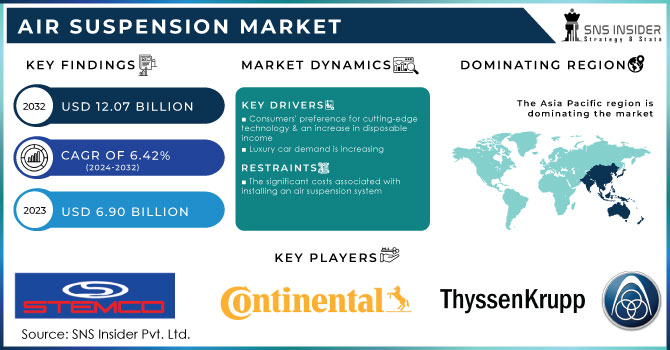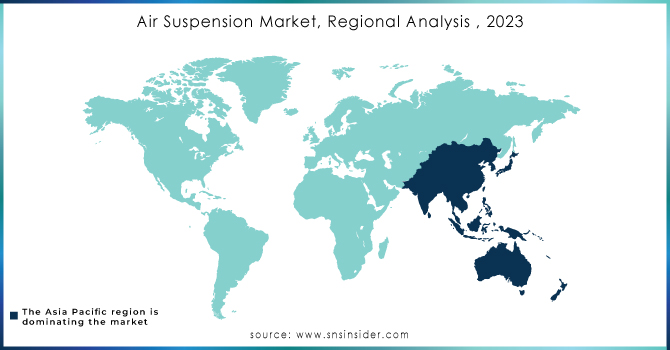Air Suspension Market Size & Overview:

Get More Information on Air Suspension Market - Request Sample Report
The Air Suspension Market Size was valued at USD 6.90 billion in 2023 and is expected to reach USD 12.07 billion by 2032 and grow at a CAGR of 6.42% over the forecast period 2024-2032.
The growing demand for luxury buses for long-distance travel, as well as the growing importance of comfort and luxury in passenger automobiles, are driving the air suspension system industry.
Air suspension is a sort of car suspension system that provides comfort to the driver while driving. Air is pumped into the suspension system, which is normally comprised of textile-reinforced rubber, by these pumps or compressors attached to the suspension system. Air suspension systems are used in cars to replace traditional steel springs and have a broader application in heavier vehicles including buses, lorries, rolling stock, and other heavy vehicles.
A decent ride offers passenger comfort, minimizes cargo damage, and lowers driver fatigue on extended journeys. Suspension is in charge of ride quality and car handling control, as cars with firm suspension can have more control over body movements and react faster. As a result of these reasons, the need for increased driving comfort has increased, influencing the air suspension industry. The future demand landscape of the Air Suspension Market is poised to undergo a transformative shift, driven by a confluence of technological advancements, evolving consumer preferences, and stringent regulatory mandates. As the automotive industry steers towards electrification and autonomous mobility, the demand for air suspension systems is expected to escalate substantially. The inherent benefits of air suspension, including enhanced ride comfort, improved fuel efficiency, and heightened safety, position it as a pivotal component in the next generation of vehicles. Furthermore, the burgeoning e-commerce sector and the consequent surge in demand for efficient commercial transportation are set to fuel the adoption of air suspension systems in heavy-duty vehicles. To thrive in this evolving market, industry stakeholders must not only focus on innovation in product development but also establish strategic collaborations to address the dynamic needs of a rapidly changing automotive landscape. Adapting to the interplay of technological innovation, environmental considerations, and shifting consumer expectations will be key to unlocking the full potential of the future Air Suspension Market.
MARKET DYNAMICS:
KEY DRIVERS:
-
Consumers' preference for cutting-edge technology & an increase in disposable income
-
Luxury car demand is increasing
-
Production of both passenger and commercial automobiles is increasing
-
People are opting for premium vehicles because they want all of the safety features and a smooth ride
In the contemporary automotive landscape, an increasing number of discerning consumers are gravitating towards premium vehicles, driven by a collective desire for uncompromising safety features and an unparalleled smooth ride experience. This shift in consumer preference is particularly evident in the burgeoning Air Suspension Market, where cutting-edge technologies converge to redefine vehicular dynamics. The discerning clientele of today views their vehicles not merely as modes of transportation but as sanctuaries of security and comfort.
RESTRAINTS:
-
The significant costs associated with installing an air suspension system
-
The maintenance involved with air suspension can stifle market expansion
OPPORTUNITIES:
-
Consumers choose to install cutting-edge technology in their vehicles in order to have a smooth ride
-
An increasing number of automakers are emphasizing the inclusion of more comfortable amenities in their vehicles
-
The development of lightweight air suspension systems and technological advances
The evolution of lightweight air suspension systems represents a pivotal chapter in the dynamic landscape of the Air Suspension Market. Technological strides have propelled this sector into a realm of unprecedented innovation and efficiency. The relentless pursuit of enhanced performance, fuel efficiency, and ride comfort has led to the development of cutting-edge air suspension solutions that redefine industry standards. By integrating advanced materials and sophisticated engineering, manufacturers have successfully achieved the delicate balance between durability and reduced weight, thereby optimizing overall vehicle performance.
CHALLENGES:
-
The high cost of installing suspension systems in automobiles
-
The market's expansion is projected to be hampered by its complex structure
IMPACT OF RUSSIA UKRAINE WAR:
As geopolitical tensions escalate, the air suspension market faces a complex web of challenges. The conflict has disrupted supply chains, leading to shortages in raw materials and components crucial to the manufacturing of air suspension systems. Heightened uncertainty in the region has also dampened investor confidence, causing fluctuations in currency exchange rates that further strain the market. Additionally, the increased focus on defence and security measures in various nations has redirected resources and attention away from civilian industries, including automotive technologies like air suspension. The war's influence on energy prices, particularly in terms of fuel costs, has added an extra layer of concern for the air suspension market, as manufacturers and consumers alike grapple with the economic repercussions of a protracted conflict. In this turbulent environment, adaptability and resilience will be key for the air suspension sector to navigate the challenges posed by the Russia-Ukraine war and emerge stronger in the post-conflict landscape.
IMPACT OF ECONOMIC SLOWDOWN:
The Air Suspension Market is currently grappling with the impact of an economic slowdown, presenting a formidable challenge to its growth trajectory. The deceleration is underscored by a confluence of factors, including global uncertainties, supply chain disruptions, and fluctuating consumer demand. This economic downturn has prompted a reassessment of investment priorities within the automotive sector, affecting the adoption of air suspension systems. Manufacturers are confronted with the need to navigate through cost pressures, reduced consumer spending, and a cautious approach to capital expenditures. As businesses recalibrate strategies to weather the economic headwinds, the Air Suspension Market finds itself in a phase of introspection, seeking innovative solutions and operational efficiencies to regain momentum in the face of challenging economic conditions. The resilience and adaptability of market players will be pivotal in determining the sector's ability to rebound and thrive in the post-downturn landscape.
MARKET SEGMENTATION:
By Vehicle Type:
-
Passenger car
-
Commercial vehicle
By Technology:
-
Manual Air Suspension
-
Electronic Air Suspension
By Component:
-
Shock Absorber
-
Air Spring
-
Height sensor
-
Air compressor
-
Electric control unit
-
Air Reservoir
-
Others
The air suspension market is segmented by component, with the air compressor segment holding the largest share, exceeding 31% in 2021. This segment plays a crucial role in inflating and regulating the air springs, directly impacting the system's functionality and performance. Following closely behind are air springs, accounting for over 28% of the market share. These components act as the foundation of the system, absorbing shock and vibrations while maintaining ride height. The remaining market share is distributed amongst other vital components like height sensors, electronic control units (ECUs), and shock absorbers, each contributing to the overall performance and user experience of the air suspension system.
By End-user:
-
OEM
-
Aftermarket
REGIONAL ANALYSIS:
The urban population in the Asia Pacific is steadily expanding, owing to improved employment possibilities and higher living standards in urban regions. The increasing focus on environmental sustainability and fuel efficiency in the region drives the adoption of air suspension systems, emphasizing the pivotal role APAC plays in steering the trajectory of the global Air Suspension Market. The balance between tradition and innovation within the diverse APAC markets creates a unique tapestry, shaping the future dynamics of the air suspension industry in this vibrant region.
Because the region includes quickly rising economies like China, Japan, and India, this industry in the region is expected to grow rapidly. China is driving the market in the Asia Pacific, where the adoption of air suspension systems in automobiles is expanding. As a result, the vehicle air suspension system industry in the country is booming.

Get Customized Report as per your Business Requirement - Request For Customized Report
REGIONAL COVERAGE:
North America
-
US
-
Canada
-
Mexico
Europe
-
Eastern Europe
-
Poland
-
Romania
-
Hungary
-
Turkey
-
Rest of Eastern Europe
-
-
Western Europe
-
Germany
-
France
-
UK
-
Italy
-
Spain
-
Netherlands
-
Switzerland
-
Austria
-
Rest of Western Europe
-
Asia Pacific
-
China
-
India
-
Japan
-
South Korea
-
Vietnam
-
Singapore
-
Australia
-
Rest of Asia Pacific
KEY PLAYERS:
Continental AG (Germany), Stemco, ThyssenKrupp AG (Germany), Firestone Industrial Products (US), Hitachi Ltd. (Japan), Wabco Holdings Inc. (Belgium), SAF-Holland (Germany), Hendrickson International Corporation (US), LORD Corporation, Accuair Suspension (US), Airlift Company, Magneti Marelli S.p.A., and Mando Corporation are some of the major players in the air suspension market (South Korea). Continental used expansion, new product development, collaboration, and mergers and acquisitions to maintain its leading position in the air suspension business, whereas ThyssenKrupp relied on expansion to maintain its market position.
RECENT DEVELOPMENTS:
-
Continental AG have unveiled groundbreaking technologies aimed at enhancing ride comfort and vehicle stability.
-
WABCO Holdings Inc. has forged strategic partnerships to integrate intelligent air suspension systems with cutting-edge electronic control units, paving the way for a seamless and responsive driving experience.
-
Arnott Inc., known for its expertise in aftermarket air suspension solutions, has introduced innovative products designed to cater to a diverse range of vehicle models.
| Report Attributes | Details |
|---|---|
| Market Size in 2023 | US$ 6.90 Billion |
| Market Size by 2032 | US$ 12.07 Billion |
| CAGR | CAGR of 6.42% From 2024 to 2032 |
| Base Year | 2023 |
| Forecast Period | 2024-2032 |
| Historical Data | 2020-2022 |
| Report Scope & Coverage | Market Size, Segments Analysis, Competitive Landscape, Regional Analysis, DROC & SWOT Analysis, Forecast Outlook |
| Key Segments | • by Vehicle Type (Passenger car, Commercial vehicle) • by Technology (Manual Air Suspension, Electronic Air Suspension) • by Component (Shock Absorber, Air Spring, Height sensor, Air compressor, Electric control unit, Air Reservoir, Others) • by End-user (OEM, Aftermarket) |
| Regional Analysis/Coverage | North America (US, Canada, Mexico), Europe (Eastern Europe [Poland, Romania, Hungary, Turkey, Rest of Eastern Europe] Western Europe] Germany, France, UK, Italy, Spain, Netherlands, Switzerland, Austria, Rest of Western Europe]), Asia Pacific (China, India, Japan, South Korea, Vietnam, Singapore, Australia, Rest of Asia Pacific), Middle East & Africa (Middle East [UAE, Egypt, Saudi Arabia, Qatar, Rest of Middle East], Africa [Nigeria, South Africa, Rest of Africa], Latin America (Brazil, Argentina, Colombia, Rest of Latin America) |
| Company Profiles | Continental AG (Germany), Stemco, ThyssenKrupp AG (Germany), Firestone Industrial Products (US), Hitachi Ltd. (Japan), Wabco Holdings Inc. (Belgium), SAF-Holland (Germany), Hendrickson International Corporation (US), LORD Corporation, Accuair Suspension (US), Airlift Company, Magneti Marelli S.p.A., and Mando Corporation are some of the major players in the air suspension market (South Korea). Continental used expansion, new product development, collaboration, and mergers and acquisitions to maintain its leading position in the air suspension business, whereas ThyssenKrupp |
| Key Drivers | •Consumers' preference for cutting-edge technology & an increase in disposable income. •Luxury car demand is increasing. |
| RESTRAINTS | •The significant costs associated with installing an air suspension system. •The maintenance involved with air suspension can stifle market expansion. |

